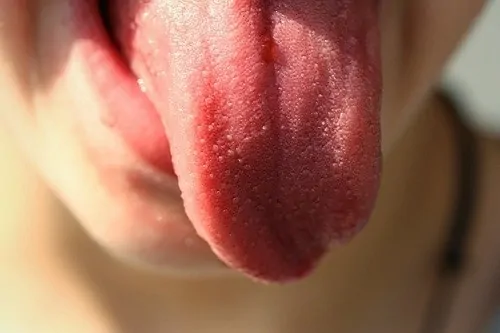
Usually you’ll find your dentist in Douglasville spending most of their time talking about teeth. But today, we’re switching it up a bit and focusing on another important area of oral health — the tongue. This amazing muscle helps us speak, chew, and swallow, but did you know that our tongues can also help your dental team identify oral health problems- or even other whole-body problems? Say “Ah!” and let’s take a look at some ways our tongues can be the window to overall health.
A Bright Red Tongue
Tongues are usually a nice shade of pink — this indicates a well-hydrated and healthy tongue. But there are also times when patients look in their mouths to find a bright red tongue. The color can be so dramatic that it can appear as if you just ate a red popsicle that stained your tongue. A red tongue is often referred to as strawberry tongue and can indicate a vitamin B-12 deficiency or an iron deficiency. Occasionally, a red tongue may also be a sign of a fever, strep throat, Kawasaki disease, or erythroplakia. Erythroplakia may increase the likelihood of developing oral cancer, so any tongue redness that doesn’t go away warrants a call to your dentist in Douglasville.
Scalloped or Wavy Edges
If it’s been a while since you’ve last looked at your tongue, you may now notice changes in its texture, particularly a scalloped or wavy appearance along the edges. This is usually nothing to be concerned about but can be a sign of other problems. Scalloped or wavy edges often result from the tongue being pushed up against the teeth repeatedly. This can even happen during sleep! This change in tongue texture can also be a sign of teeth grinding, sleep apnea, TMJ disorder, or vitamin deficiencies.
A Black, Hairy Tongue
As gross as this sounds and as scary as it can be, usually a black, hairy tongue isn’t anything to worry about. This condition can be caused by poor oral hygiene, smoking or chewing tobacco, drinking too much alcohol, dry mouth, or changes to yeast or bacteria in the mouth. Also, the “hair” you see isn’t actually hair but rather a buildup of skin cells on the papillae (the tiny bumps naturally found on tongues). When too many cells take over the papillae, they can appear long and hair-like as opposed to small bumps. This condition can resolve on its own.
Painful Sores or Bumps
As we’ve mentioned before, all tongues have tiny bumps called papillae. Those are normal and are no cause for concern. However, when a new bump appears and is accompanied by pain or soreness and doesn’t go away, you should visit your dentist in Douglasville. New lumps that don’t go away over the course of two weeks may be a sign of oral cancer. Oral cancer can be treated, but treatment is often more successful when the cancer is caught early. Call your dentist as soon as you can to get it checked out.
Your tongue can say a lot about your overall health, and it shouldn’t be ignored. Keep a close eye on your tongue in-between your dental appointments and be sure to talk about any changes you may notice with your dental team.

